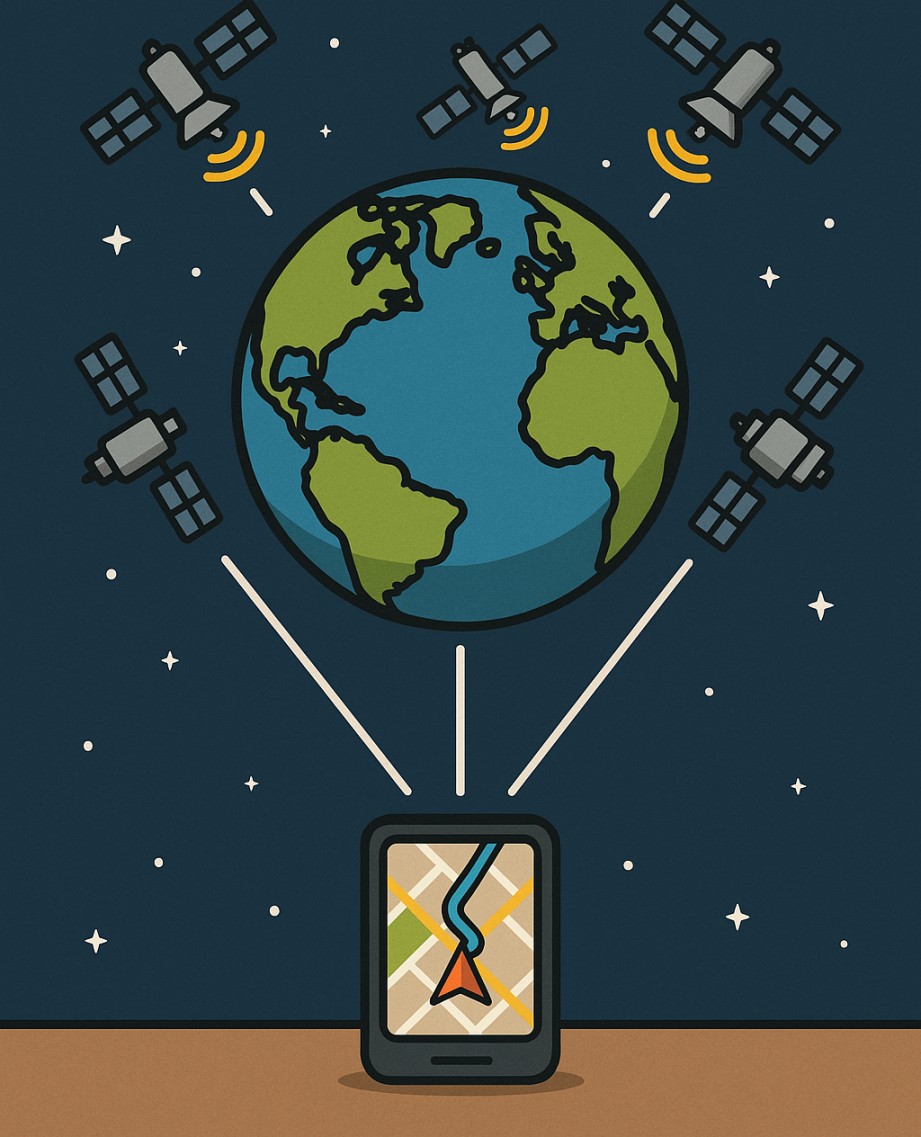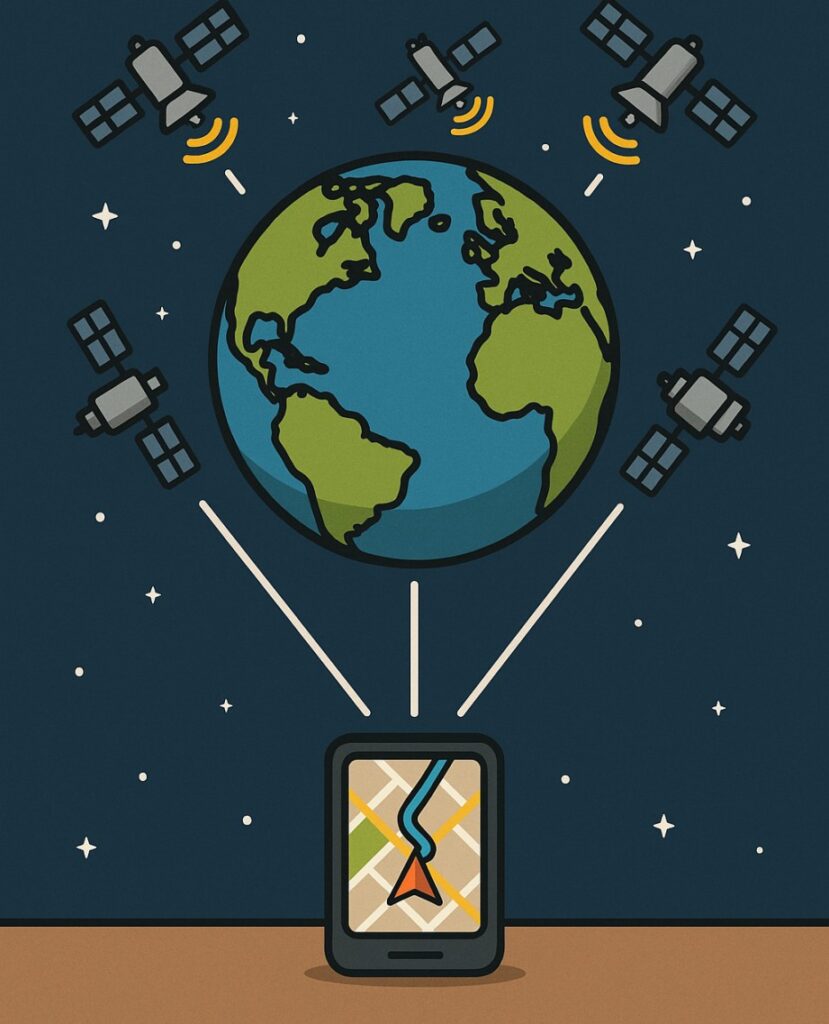
In today’s fast-paced world, losing track of something or someone can feel like a nightmare. Whether it’s keeping tabs on your car in a crowded parking lot, making sure your kid gets home safely, or ensuring a delivery arrives on time, GPS tracking devices have become lifesavers. These little gadgets use cutting-edge technology to pinpoint locations with incredible accuracy, giving us peace of mind in a chaotic world.
But what exactly are GPS tracking devices? How do they work, and what kinds are out there? In this article, we’ll dive into the world of GPS trackers, explore their different types, and see how they’re used in everyday life. Whether you’re curious about tracking your pet or optimizing a business, Kommnet Technologies got you covered with easy-to-understand explanations.

Understanding GPS Tracking Devices
How GPS Tracking Works
GPS stands for Global Positioning System, a network of about 31 satellites orbiting Earth, maintained by the U.S. government. These satellites constantly send signals to GPS receivers on the ground. A GPS device needs signals from at least four satellites to calculate its precise location using a process called trilateration. This process measures the time it takes for signals to travel from the satellites to the device, determining its latitude, longitude, and sometimes altitude.
For example, when you use a GPS tracker to find your car, the device communicates with satellites to figure out its exact spot—down to a few meters! Most modern trackers also connect to cellular networks or Wi-Fi to send this location data to your phone or computer in real time.
Key Components of GPS Devices
Every GPS tracking device has a few core parts that make it tick:
- GPS Chip: This is the brain of the device, receiving satellite signals to calculate location.
- Transmitter: Sends the location data to your phone, computer, or a tracking platform, often via cellular networks (like 4G) or Bluetooth.
- Battery: Powers the device. Some trackers have rechargeable batteries, while others use replaceable ones.
- Antenna: Boosts signal reception, especially in areas with weak satellite or cellular coverage.
Advanced trackers might also include extras like:
- Emergency Buttons: For sending SOS alerts.
- Two-Way Audio: Allows communication, like a phone call.
- Motion Sensors: Detect movement to save battery or trigger alerts.
- Waterproofing: Protects the device in harsh conditions, like rain or snow.
Main Types of GPS Tracking Devices
Personal GPS Trackers
Personal GPS trackers are small, portable devices designed for individuals. They’re lightweight and easy to carry, making them perfect for keeping tabs on people you care about or tracking your own adventures.
For Kids and Elderly
These trackers are a game-changer for families. Parents can use them to monitor their kids’ locations, especially during school commutes or playdates. Trackers for kids often come as wearable devices, like bracelets or clip-ons, with features like:
- Panic Buttons: Kids can press a button to alert parents in an emergency.
- Geofencing: Sends an alert if the child leaves a designated “safe zone,” like home or school.
- Two-Way Calling: Some devices let parents call their child directly.
For elderly people, especially those with dementia or mobility issues, trackers provide safety. Devices like the AngelSense tracker include fall detection, voice communication, and even a feature to detect if the wearer is in distress. For example, a number of families with dementia patients reported reduced stress after using GPS trackers.
For Fitness and Outdoor Use
Fitness enthusiasts love GPS trackers for tracking routes, speeds, and distances. Devices like the Fitbit smartwatches have built-in GPS to map your morning run or mountain hike. These trackers can:
- Record elevation changes for hikers or skiers.
- Sync with apps like Strava to share your progress.
- Monitor heart rate or calories burned alongside location data.
Outdoor adventurers, such as campers or kayakers, use rugged GPS trackers like the SPOT Gen4, which works in remote areas without cell service by connecting directly to satellites. These devices often include SOS features to call for help in emergencies, like getting lost in the wilderness.
Vehicle GPS Trackers
Vehicle GPS trackers are designed for cars, motorcycles, trucks, or even boats. They’re either hardwired into the vehicle’s power system or plugged into ports like the OBD-II (On-Board Diagnostics).
Car Tracking
Ever parked your car at a festival and forgotten where it was? A car GPS tracker, like the Kommnet GPS tracking system, can save the day. These devices provide real-time location updates to your phone. If your car is stolen, trackers help police recover it. These tracking systems, like the Kommnet, also monitor driving habits, alerting parents if their teen is speeding.
Fleet Management
Businesses with delivery trucks or service vans use GPS trackers to streamline operations. Fleet tracking systems, like Kommnet fleet management system, track multiple vehicles at once. They help companies:
- Optimize routes to save time and fuel.
- Monitor driver behavior, like harsh braking or idling.
- Schedule maintenance based on mileage or engine data.
For example, a pizza delivery chain might use trackers to ensure drivers take the fastest routes, improving customer satisfaction.
Asset GPS Trackers
Asset trackers protect valuable items that aren’t people or vehicles. They’re perfect for businesses or individuals who need to monitor expensive or critical objects.
Luggage and Shipment
Lost luggage is a traveler’s worst fear. GPS trackers like the AirTag let you monitor your suitcase in real time. These devices are small enough to slip into a bag and can send alerts if your luggage is opened or moved. For businesses, shipment trackers monitor cargo containers, ensuring goods arrive on time.
High-Value Equipment

Construction sites, film studios, and hospitals use asset trackers to protect pricey equipment. For instance, a bulldozer worth 10 million Rupees might have a GPS tracker like the Kommnet heavy equipment tracker, which is easy to use. These trackers deter theft and help recover stolen items. They also track usage, so companies know when equipment needs maintenance.
Pet GPS Trackers
Pet GPS trackers are a must for furry friends who love to wander. Devices like the Whistle GO attach to a pet’s collar and provide real-time location updates. Features include:
- Activity Monitoring: Tracks your pet’s exercise, like how far your dog ran at the park.
- Geofencing: Alerts you if your cat sneaks out of the backyard.
- Waterproof Design: Perfect for pets who love puddles.
These devices are especially popular for dogs, cats, and even horses!
Phone-Based GPS Tracking Apps
Your smartphone is a powerful GPS tracker thanks to apps like Google Maps, or Find My iPhone. These apps use your phone’s built-in GPS chip to share your location with family or friends. They’re super convenient because you don’t need extra hardware, but they have limitations:
- They require an internet connection (Wi-Fi or cellular).
- Battery drain can be significant if tracking is always on.
- They’re less reliable in remote areas with poor signal.
For example, some apps lets families create “circles” to track each other’s locations, with features like crash detection for drivers. However, these apps are best for casual use, not heavy-duty tracking.
Active vs Passive GPS Trackers
Key Differences
GPS trackers come in two main flavors: active and passive.
- Active GPS Trackers: These send location updates in real time, usually via cellular networks. You can track a device’s movement live on your phone or computer. For example, a parent might use an active tracker to see their child’s school bus route as it happens.
- Passive GPS Trackers: These store location data on the device itself, like a digital diary. You retrieve the data later by connecting the tracker to a computer. They’re often used for logging routes, like tracking a delivery truck’s journey after it returns.
Pros and Cons
Here’s a quick comparison:
| Type | Pros | Cons |
| Active | Real-time updates, ideal for live tracking | Needs internet, higher cost, battery drain |
| Passive | No internet needed, cheaper, long battery life | No live updates, requires manual data retrieval |
Active trackers are pricier, while passive trackers are a one-time purchase, making them budget-friendly for non-urgent tracking.
Real-Life Uses of GPS Trackers
Personal Safety
GPS trackers are a lifeline for personal safety. Parents use these devices to monitor kids walking home from school. Elderly individuals with Alzheimer’s wear trackers like the PocketFinder, which alert caregivers if they wander too far.
Business Logistics
Companies rely on GPS trackers to keep supply chains humming. Retail giants like Amazon use them to track delivery vans, ensuring packages arrive on time. Logistics firms save millions annually by optimizing routes and reducing idle time. Also some small businesses use trackers to help monitor local deliveries or service calls.
Law Enforcement
Police departments use GPS trackers to solve crimes. For example, they might place a tracker on a suspect’s car (with a warrant) to monitor their movements. Trackers also help recover stolen goods, like electronics or jewelry, by pinpointing their location.
Emergency Services
GPS trackers save lives in emergencies. Ambulances use GPS to find the fastest route to a patient, cutting response times by up to 20%, per a 2024 emergency services study. Fire trucks and search-and-rescue teams use trackers to navigate disasters, like wildfires or floods, where roads may be blocked.
Wildlife Conservation
Scientists use GPS trackers to study animals and protect endangered species. For example, trackers on sea turtles help researchers map migration patterns, while trackers on rhinos deter poachers. These devices are often solar-powered to last months in the wild.
Features to Look for in a GPS Tracker
Choosing the right GPS tracker depends on your needs. Here are key features to consider:
- Battery Life: Some trackers last up to two weeks on a single charge while Some GPS tracking systems get power directly from the electric system on the vehicle. Others, like fitness trackers, need daily charging. Pick one that matches your tracking duration.
- Real-Time Tracking: Active trackers with cellular plans provide live updates every few seconds. Essential for tracking kids, pets, or vehicles.
- Size and Portability: Smaller trackers are easier to hide or carry. Larger ones, like fleet trackers, are bulkier but have stronger signals.
- Geofencing: This feature sends alerts when a tracker leaves a set area, like your home or office. It’s great for pets, kids, or equipment.
- Durability: Look for waterproof and shock-resistant trackers, if they’ll be used outdoors or on rough terrain.
- App Integration: A user-friendly app (e.g., Kommnet GPS tracking app) makes tracking simple, with maps, history logs, and alerts.
The Future of GPS Tracking Technology
Integration with AI and IoT
The future of GPS tracking is exciting, thanks to artificial intelligence (AI) and the Internet of Things (IoT). Smart homes could use GPS to automate tasks like opening your garage door when your car’s tracker is 100 meters away. AI-powered trackers might predict traffic jams or suggest eco-friendly routes. For example, Tesla’s navigation system already combines GPS with AI to optimize driving paths.
IoT connects GPS trackers to other devices, creating a “smart” network. In smart cities, traffic lights could adjust based on GPS data from buses and ambulances, reducing congestion.
Miniaturization and Wearables
GPS tech is shrinking fast. Soon, trackers could be as small as a button, embedded in jewelry, shoes, or even clothing. Researchers are developing flexible GPS chips that can be woven into fabric, perfect for wearables.
Improved Accuracy
New satellite systems, like Europe’s Galileo or China’s BeiDou, are making GPS even more precise—down to centimeters! This could revolutionize fields like autonomous driving, where cars need exact location data to navigate safely.
Are GPS Trackers Legal?
GPS trackers are generally legal, but there are important rules to follow:
- You Can Track:
- Your own property (e.g., car, luggage, equipment).
- Your kids or pets, with consent if they’re old enough to understand.
- Employees’ company vehicles, if they’re informed.
- You Can’t Track:
- Someone else’s property without permission.
- A person without their knowledge or consent (e.g., spying on a friend).
- Government or public property, like a city bus.
Laws vary by country and state. For example, California requires consent for tracking adults, while Texas allows tracking of personal property without restrictions. Always check local regulations before using a tracker to avoid legal trouble.
Conclusion
GPS tracking devices are more than just gadgets. They’re tools that make life safer, easier, and more efficient. From keeping your dog from running off to helping businesses save millions, these devices are everywhere. By understanding the types of trackers, their features, and their uses, you can pick the perfect one for your needs. As technology evolves, GPS trackers will only get smarter, smaller, and more powerful, opening up new possibilities for how we stay connected to the world around us.
